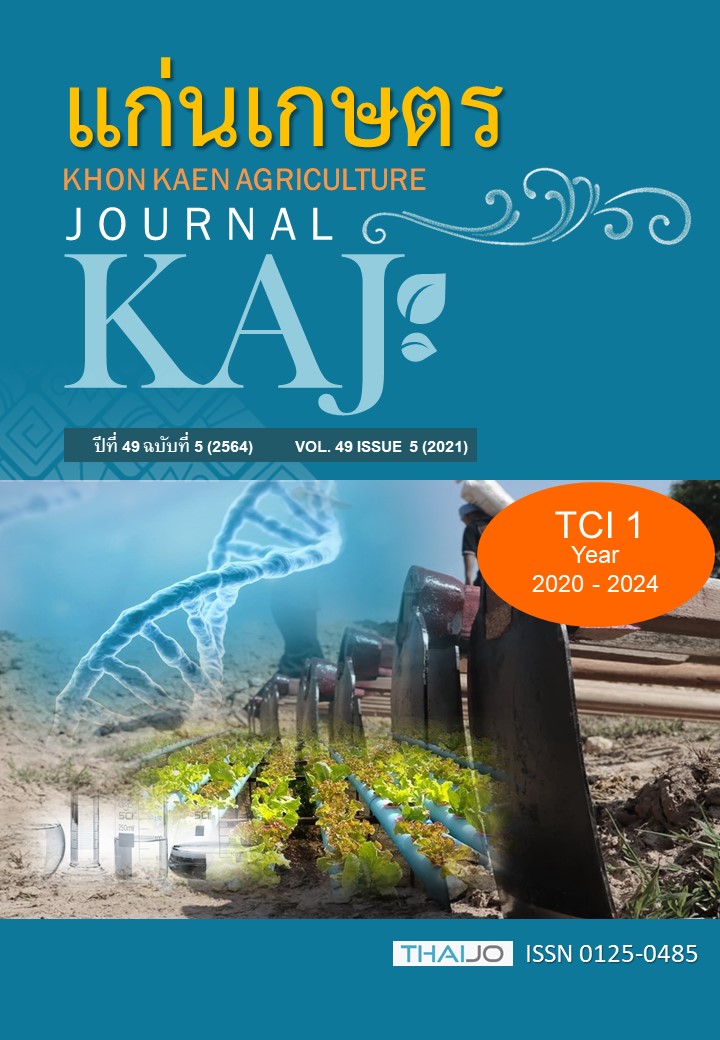การพัฒนาเครื่องหมายดีเอ็นเอที่จำเพาะต่อยีนแว็กซี่ เพื่อการประยุกต์ใช้ในโปรแกรมปรับปรุงพันธุ์ข้าวเหนียวดำจากข้าวเจ้าไรซ์เบอร์รี่
Main Article Content
บทคัดย่อ
โปรแกรมการปรับปรุงพันธุ์ข้าวเหนียวหอมสีดำจากข้าวเจ้าไรซ์เบอร์รี่ จะใช้ข้าวเหนียว กข6 เป็นพันธุ์ให้ เพื่อถ่ายทอดยีนแว็กซี่ (Waxy) ซึ่งเป็นยีนที่ควบคุมการสร้างแป้งแอมิโลสในเมล็ดข้าว มีผลต่อคุณภาพหุงต้มและความอ่อนแข็งของข้าวหุงสุก และเป็นตัวกำหนดความเป็นข้าวเจ้าหรือข้าวเหนียว งานวิจัยนี้มีวัตถุประสงค์เพื่อออกแบบเครื่องหมายดีเอ็นเอที่จำเพาะต่อยีน Waxy สำหรับใช้คัดเลือกต้นข้าวที่มียีนเป้าหมาย จากการออกแบบเครื่องหมายดีเอ็นเอจำนวน 3 คู่ไพร์เมอร์ ได้แก่ waxy-1, waxy-2 และ waxy-3 ที่จำเพาะต่อยีน Waxy บริเวณปลาย 5' กลางยีน และปลาย 3' ตามลำดับ แล้วนำไปตรวจสอบจีโนไทป์ในเชื้อพันธุกรรมข้าว จำนวน 61 พันธุ์ พบว่า เครื่องหมายดีเอ็นเอ waxy-1, waxy-2 และ waxy-3 มีรูปแบบแถบดีเอ็นเอจำนวน 6 3 และ 2 แบบ ตามลำดับ ในจำนวนนี้ มีเพียงเครื่องหมายดีเอ็นเอ waxy-1 ที่แยกอัลลีลของข้าวเจ้าพันธุ์ไรซ์เบอร์รี่ออกจากอัลลีลของข้าวเหนียวพันธุ์ กข6 ได้ โดยแสดงรูปแบบของแถบดีเอ็นเอที่แตกต่างกัน จากนั้นใช้เครื่องหมายดีเอ็นเอ waxy-1 ตรวจสอบจีไนไทป์ในประชากรข้าวลูกผสมชั่วที่ F1 จากคู่ผสมระหว่างข้าวไรซ์เบอร์รี่ x กข6 พบว่า ประชากรชั่วแรก F1 แสดงจีโนไทป์เป็นเฮเทอไรไซกัสอย่างชัดเจน แสดงว่าเครื่องหมายดีเอ็นเอ waxy-1 สามารถใช้สำหรับติดตามการถ่ายทอดยีน Waxy จากข้าวเหนียว กข6 ไปสู่ข้าวสายพันธุ์ปรับปรุงที่มาจากคู่ผสมนี้ได้ นอกจากนี้เครื่องหมายดีเอ็นเอที่ได้ อาจจะนำไปประยุกต์ใช้ในโครงการปรับปรุงพันธุ์ข้าวอื่น ๆ ได้อีกด้วย
Article Details

อนุญาตภายใต้เงื่อนไข Creative Commons Attribution-NonCommercial-NoDerivatives 4.0 International License.
เอกสารอ้างอิง
http://www.ricethailand.go.th/rkb3/title-index.php-file=content.php&id=6-2.htm. ค้นเมื่อ 22 สิงหาคม 2561.
เครือวัลย์ อัตตะวิริยะสุข. 2536. คุณภาพเมล็ดข้าวทางกายภาพและการแปรสภาพเมล็ด. น. 1-53. ใน: เอกสารประกอบการบรรยายฝึกอบรมหลักสูตรวิทยาการหลังการเก็บเกี่ยว ณ ศูนย์วิจัยข้าวพัทลุง. กรมวิชาการเกษตร, กรุงเทพฯ.
ชลธิดา ชลธิศชโลทร, นภา ตั้งเตรียมจิตมั่น, เบญจวรรณ ชิวปรีชา, และอรสา สุริยาพันธ์. 2563. ปัจจัยที่มีผลต่อการวิเคราะห์อะไมโลสในตัวอย่างข้าวเจ้าด้วยวิธีจับกับไอโอดีน. วารสารวิทยาศาสตร์และเทคโนโลยี. 28(11): 1929-1941.
ฉันทมาศ เชื้อแก้ว, พัชรี ลาโคตร, นพมาศ นามแดง, วชิราพรรณ บุญญาพุทธิพงศ์, และสุรีพร เกตุงาม. 2560. ความผันแปรของยีน Waxy ที่มีผลต่อปริมาณอะไมโลสในข้าวพื้นเมืองอุบลราชธานี. แก่นเกษตร. 45(ฉบับพิเศษ 1): 1142-1148.
อรอนงค์ วินัยกุล. 2550. ข้าว: วิทยาศาสตร์และเทคโนโลยี. สำนักพิมพ์มหาวิทยาลัยเกษตรศาสตร์, กรุงเทพฯ.
Aoki, N., T. Umemoto, S. Yoshida, T. Ishii, O. Kamijima, U. Matsukura, and N. Inouchi. 2006. Genetic analysis of long chain synthesis in rice amylopectin. Euphytica. 151: 225-234.
Caetano, A. 1997. Resolving DNA amplification products using polyacrylamide gel electrophoresis and silver staining, P.119-134. In: R. M. Micheli, and R. Bova. (Eds.), Fingerprinting methods based on PCR, Springer-Verlag, Heidelberg.
Cai, X. L., Z. Y. Wang, Y. Y. Xing, Y. Y. Xing, J. L. Zhang, and M. M. Hong. 1998. Aberrant splicing of intron 1 leads to the heterogeneous 5' UTR and decreased expression of waxy gene in rice cultivars of intermediate amylose content. The Plant Journal. 14(4): 459-465.
Chen, M. H., C. Bergman, S. Pinson, and R. Fjellstrom. 2008. Waxy gene haplotypes: associations with apparent amylose content and the effect by the environment in an international rice germplasm collection. Journal of Cereal Science. 47: 536-545.
CIRAD. 2019. DARwin: dissimilarity analysis and representation for windows. Available: http://darwin.cirad.fr/. Accessed Feb. 20, 2020.
Gao, L., M. Zhou, R. Chen, H. Gao, Q. Yan, W. Zhou, and G. Deng. 2012. Developing and validating the functional marker of rice waxy gene, M-Wx. Rice Genomics and Genetics. 3(10): 61-65.
Juliano, B.O. 2007. Rice chemistry and quality, Muñoz, Nueva Ecija, Philippines: Philippine Rice Research Institute.
Juliano, B. O., C. M. Perez, and A. P. Resurreccion. 2009. Apparent amylose content and gelatinization temperature types of Philippine rice accessions in the IRRI gene bank. Philippine Agricultural Scientist. 92(1): 106-109.
Juliano, B. O., C. M. Perez, A. B. Blakeney, T. Castillo, N. Kongseree, B. Laignelet, E. T. Lapis, V. V. S. Murty, C. M. Paule, and B. D. Webb. 1981. International cooperative testing on the amylose content of milled rice. Starch. 33(5): 157-162.
Jantaboon, J., M. Siangliw, S. Im-mark, W. Jamboonsri, A. Vanavichit, and T. Toojinda. 2011. Ideotype breeding for submergence tolerance and cooking quality by marker-assisted selection in rice. Field Crops Research. 123(3): 206-213.
Larkin, P. D., and W. D. Park. 2003. Association of waxy gene single nucleotide polymorphisms with starch characteristics in rice (Oryza sativa L.). Molecular Breeding. 12: 335–339.
Prathepha, P., and V. Baimai. 2004. Variation of Wx microsatellite allele, waxy allele distribution and differentiation of chloroplast DNA in a collection of Thai rice (Oryza sativa L.). Euphytica. 140: 231–237.
Sano, Y. 1984. Differential regulation of waxy gene expression in rice endosperm. Theoretical and Applied Genetics. 68: 467–473.
Sano, Y., M. Katsumata, and K. Okuno. 1986. Genetic studies of speciation in cultivated rice. 5. Inter- and intraspecific differentiation in the waxy gene expression of rice. Euphytica. 35: 1–9
Wanchana, S., T. Toojinda, S. Tragoonrung, and A. Vanavichit. 2003. Duplicated coding sequence in the waxy allele of tropical glutinous rice (Oryza sativa L.). Plant Science Letters. 165: 1193–1199.
Wang, Z. Y., Z. L. Wu, Y. Y. Xing, F. G. Zheng, X. L. Guo, W. G. Zhang, and M. M. Hong. 1990. Nucleotide sequence of rice waxy gene. Nucleic Acids Research. 18: 5898.
Wang, Z. Y., F. Q. Zheng, G. Z. Shen, J. P. Gao, P. S. Snustad, M. G. Li, J. L. Zhang, and M. H. Hong. 1995. The amylose content in rice endosperm is related to the post-transcriptional regulation of the waxy gene. The Plant Journal. 7(4): 613-622.
Yamanaka, S., I. Nakamura, K. N. Watanabe, and Y. Sato. 2004. Identification of SNPs in the waxy gene among glutinous rice cultivars and their evolutionary significance during the domestication process of rice. Theoretical and Applied Genetics. 108: 1200–1204.
Yi, M., T. Nwea, A. Vanavichit, W. Chai-aree, and T. Toojinda. 2009. Marker assisted backcross breeding to improve cooking quality traits in Myanmar rice cultivar Manawthukha. Field Crops Research. 113: 178-186.
Yunyan, F., Y. Jie, W. Fangquan, F. Fangjun, L. Wenqi, W. Jun, X. Yang, Z. Jinyan, and H. Weigong. 2019. Production of two elite glutinous rice varieties by editing Wx gene. Rice Science. 26(2): 118-124.
Zhou, L., S. Chen, G. Yang, W. Zha, H. Cai, S. Li, Z. Chen, K. Liu, H. Xu, and A. You. 2018. A perfect functional marker for the gene of intermediate amylose content Wx-in in rice (Oryza sativa L.). Crop Breeding and Applied Biotechnology. 18(1): 103-109.


